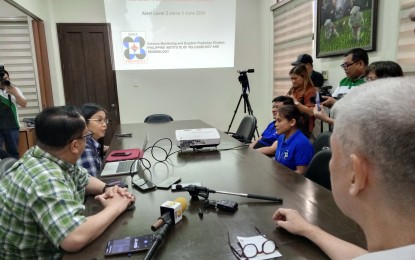
MT. KANLAON UPDATE. Philippine Institute of Volcanology and Seismology Director Teresito Bacolcol (left) and chief science research specialist Ma. Antonia Bornas (2nd from left) meet with Negros Occidental Governor Eugenio Jose Lacson at the Provincial Capitol in Bacolod City Monday afternoon (June 10, 2024). They presented the latest updates on the Mt. Kanlaon eruption and advised local government units to prepare contingency plans as the threat of magmatic eruption continues. (PNA photo by Nanette L. Guadalquiver)
BACOLOD CITY – Officials of the Philippine Institute of Volcanology and Seismology (Phivolcs) have urged local government units (LGUs) situated near Mt. Kanlaon in Negros Island to prepare contingency plans as the threat of magmatic eruption remains a week after its explosive eruption.
Phivolcs Director Teresito Bacolcol and chief science research specialist Ma. Antonia Bornas issued the advisory during a presentation on the latest updates of the Mt. Kanlaon eruption with Negros Occidental Governor Eugenio Jose Lacson at the Provincial Capitol here Monday afternoon.
“They should always be prepared for the worst case. For example, in Alert Level 3, are we prepared? Are the people ready? Our vehicles. It should be the contingency plans are in place. There are corresponding activities that they should do,” he said.
In Negros Occidental, LGUs with communities located at the foot of Mt. Kanlaon are the municipalities of La Castellana, Moises Padilla, and Murcia, as well as the cities of Bago, La Carlota, and San Carlos.
On Monday afternoon, Mayor Rhummyla Nicor-Mangilimutan said that in La Castellana, the worst-hit LGU, some 1,237 families or 4,190 individuals stay in evacuation centers.
“Our recommendation is there should be no people within the four-kilometer permanent danger zone. It’s up to the LGUs to implement it,” Bacolcol said.
In her presentation on the current outlook, Bornas said Alert Level 2 will be maintained until monitoring parameters significantly change.
“If monitoring parameters are sustained, phreatic and short-live explosive eruptions may subsequently occur and produce small-magnitude hazards that will endanger areas within the four-kilometer permanent danger,” she added.
Bornas said that in this case, unrest is likely due to hydrothermal processes driven by magmatic degassing deep within the volcanic edifice.
She said magmatic eruption may become likely if seismic, ground deformation and volcanic gas parameters worsen, and Alert Level 3 will be raised.
Bornas added that if Mt. Kanlaon would have an eventual magmatic eruption, there would be time to prepare.
“It’s a long-brewing one, unlike what happened in Taal Volcano. In one day, it was from Alert Level 1, 2, 3, and 4,” she said.
Bornas said the quick response team of Phivolcs is documenting the lahar flow recorded in the afternoon of June 5.
According to Phivolcs, grey cohesive mud, plant debris, and gravel have been deposited by lahars in at least four waterways. (PNA)
